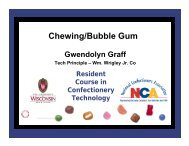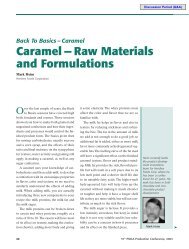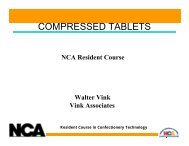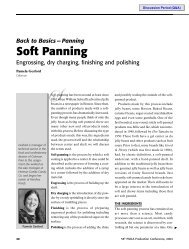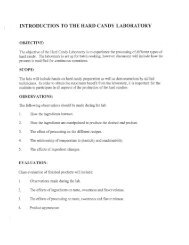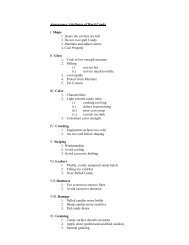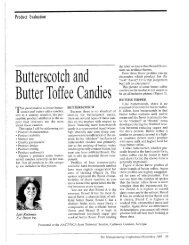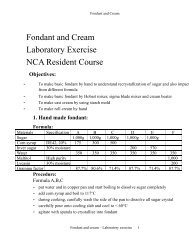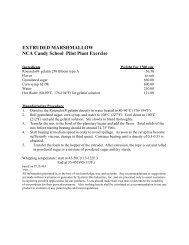2001 Grained and Ungrained Confections - staging.files.cms.plus.com
2001 Grained and Ungrained Confections - staging.files.cms.plus.com
2001 Grained and Ungrained Confections - staging.files.cms.plus.com
You also want an ePaper? Increase the reach of your titles
YUMPU automatically turns print PDFs into web optimized ePapers that Google loves.
If we take a simple syrup, add air <strong>and</strong> a<br />
protein material — a whipping agent — to<br />
help air mix into it, numerous small bubbles<br />
are formed, which weaken the syrup glue.<br />
Its density is also decreased <strong>and</strong> at the same<br />
time it be<strong>com</strong>es opaque, because the air bubbles<br />
reflect light.This gives us marshmallow<br />
confections. We can also cause some of the<br />
sugar in the syrup to crystallize, further weakening<br />
the syrup <strong>and</strong> changing its texture, producing<br />
grained marshmallows, examples of<br />
which are shown in Figure 4.<br />
We can also take this whipped syrup,<br />
uncrystallized or crystallized, add fat <strong>and</strong><br />
flavoring ingredients (such as cocoa powder)<br />
to produce the ever-popular nougats<br />
or nougatines. These vary in texture from<br />
hard torrone to the soft nougats that make<br />
up a major part of bar lines — Snickers,<br />
Milky Way, Baby Ruth <strong>and</strong> many other<br />
products, as shown in Figure 5.<br />
When we add milk to the syrup <strong>and</strong> cook<br />
it, characteristic flavors are produced. Milk<br />
protein <strong>and</strong> reducing sugars (such as dextrose,<br />
maltose or fructose), along with the<br />
sugar in the milk (lactose), react together<br />
via the Mailliard reaction to produce the<br />
flavor of caramel confections.<br />
When the syrup is made to crystallize to<br />
break up its structure, the texture be<strong>com</strong>es<br />
short <strong>and</strong> less chewy, leading to the whole<br />
range of fudges. Their texture varies with<br />
the amount of crystallization of the syrup,<br />
ranging from a grained caramel with sufficient<br />
crystallization to give the product<br />
good st<strong>and</strong>-up properties <strong>and</strong> machinability,<br />
to heavily grained hard fudge. Examples<br />
of caramel <strong>and</strong> fudge products are<br />
shown in Figure 6.<br />
Finally, if we add a gelling agent (such<br />
as gelatin, starch, pectin, etc.) the syrup is<br />
changed from one that flows to one that is<br />
immobilized in a gel structure. The resulting<br />
texture depends mainly on the gelling<br />
agent used.<br />
The molecules of sugar are effectively<br />
<strong>Grained</strong> <strong>and</strong> <strong>Ungrained</strong> <strong>Confections</strong><br />
Examples of Marshmallows<br />
Figure 4<br />
Examples of Nougats <strong>and</strong> Taffy<br />
Figure 5<br />
Examples of Caramels <strong>and</strong> Fudges<br />
Figure 6<br />
55 th PMCA Production Conference, <strong>2001</strong> 43<br />
➤



